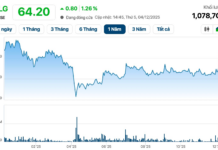Founder shareholder says “there is a big plot”
According to a document released on December 13, the Board of Directors of the Company announced that it would delist CEG shares from the Vietnam Securities Depository and Clearing Corporation (VSDC) and cancel its registration for trading on the UPCoM platform as it no longer meets the criteria of a public company after one year from January 10, 2024.
CEG became a public company in 2007 after being equitized by the Ministry of Construction, spinning off a previously state-owned enterprise, and started depositing 3.8 million shares with VSDC in 2017. The number of shares has remained unchanged since then.
The cancellation of its public company status is the first step in the merger process between CEG and its subsidiary, Construction and Industrial Equipment Joint Stock Company CIE1 (UPCoM: CE1), where CEG currently holds 54% (as of the end of 2023).
However, this process seems to be encountering some obstacles. At an extraordinary general meeting earlier this year, Mr. Truong Huu Chi – Member of the Board of Directors, did not hesitate to use strong words such as “the company’s situation is very dangerous” and “there is a big plot”. He stated that he is a founding shareholder and currently also a major shareholder of CEG, holding 7.19% of its capital (as of June 30, 2024). Including his family members, the ownership ratio is nearly 20%.
 Mr. Truong Huu Chi. Source: CEG
|
“If it is not a public company, there will be no state agency to manage and protect the interests of shareholders. Along with the weak management of the Board of Directors, it is impossible to improve the company’s capacity,” said Mr. Chi, as quoted in the minutes of the extraordinary general meeting on February 03, 2024.
According to this leader, it is “unusual” and “a big issue” for CEG to have four Board members holding between 6-9% of the shares, and he believes that there is a plot to influence the company’s and shareholders’ interests. “I disagree with the proposal at the general meeting, and I do not agree with the cancellation of the public company status,” Mr. Chi stated his opposition at the meeting.
In response, Chairman of the Board of Directors, Mr. Le Quoc Tuan, who owns 5.94% of CEG’s capital, stated that this was just the opinion of one shareholder and requested that the resolutions passed at previous general meetings be implemented.
The proposals to cancel the public company status and delist from UPCoM were subsequently approved, despite the dissent and abstention ratio exceeding 23% of the total votes cast. (About 94% of CEG’s shares attended the meeting)
The minutes of the annual general meetings in recent years have revealed some instability within the “top brass” of the company. For example, last year, Mr. Chi attributed the company’s inefficiency to human factors and internal conflicts, which have led to declining performance for the past six years, but no solutions have been presented. Previously, in his 2019 report, when he was still serving as General Director, Mr. Chi’s report did not receive full agreement from the major shareholders.
 Results of the extraordinary general meeting in early 2024. Source: CEG
|
Once hoped to cover the entire territory of Vietnam
The issue of the merger has been discussed by CEG’s leaders and shareholders for many years, mainly due to the company’s declining business performance. According to Chairman Le Quoc Tuan, the units within the same system are engaged in similar business activities, and there is a practice of assigning work to companies within the same group, leading to a lack of initiative in seeking new business opportunities, misuse of capital, and unclear responsibility for capital recovery, resulting in increasing debt despite various attempts to resolve the issue.
CEG’s previous strength was its automatic concrete mixing stations, which once dominated the market and were present in most major projects nationwide, thanks to its supply to large contractors such as the Construction Corporation, and joint ventures with foreign contractors like Obayashi and Sumitomo Mitsui…
The company once hoped to “cover the entire territory of Vietnam,” but in recent years, its market share has been gradually shrinking due to “passive management, cumbersome processes, increasing costs, and reduced competitiveness. For a long time, there has been a lack of focus on developing new products and exploring new markets,” according to the 2018 report by the Board of Directors.
From a peak of VND 289 billion in 2016, CEG’s revenue has continuously declined, reaching approximately VND 96 billion in 2023. Net profit has hovered around VND 2-3 billion for almost a decade, and last year, the company incurred a significant loss due to large provisions.
| CEG’s financial performance has been declining over the years |
Tu Kinh
Uniting the Ministries of Construction and Transportation: One Team, No ‘Us and Them’ Mentality
The consolidation proposal is based on the principle of treating the Ministry of Construction and the Ministry of Transport as one entity, without distinguishing between “us and them”. This approach allows for an honest evaluation of overlapping functions and tasks, as well as identifying areas of interconnection and cohesion.
The Master Craftsman: Unveiling the Art of Linguistic Excellence in the Digital Realm
The Ministry of Construction and Transport: A Strategic Merger, Slashing 40% of Redundancies
Following the reorganization, merger, and consolidation of the Ministry of Construction and the Ministry of Transport, the number of departments has been reduced from 42 to a more streamlined 25-27 units, reflecting a significant 35-40% decrease in the total number of departments.
“A Lean, Mean Machine”: Vice Prime Minister Ho Duc Phoc on Vietnam’s Path to Efficiency and Effectiveness
The consolidation of the Ministry of Information and Communications and the Ministry of Science and Technology is a strategic move to optimize resources and synchronize policies. This merger aims to drive the development of science, technology, innovation, and digital transformation while enhancing service quality for citizens and businesses.










































